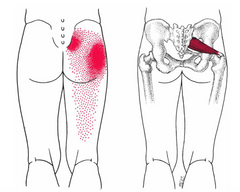The Piriformis muscle is a deep glute muscle and a powerful external hip rotator. The Piriformis muscle connects from the sacrum (tailbone) to the top of the femur, and has the capacity to cause a ton of pain in the body.

Piriformis Muscle Anatomy
The Piriformis muscle is known as the largest of the hip rotator muscles. Piriformis connects from the sacrum (tailbone) to the greater trochanter (top of the femur) and runs underneath the large Gluteus Maximus muscle [1].

Piriformis Muscle
Piriformis Muscle Function
The Piriformis muscle predominantly functions as an external hip rotator. To contract the Piriformis muscle, rotate the leg outward so that the knee is pointing toward the side of the body [2].
Piriformis is very active during high impact sports, particularly in sports with lateral movements. Sports like tennis, football, and basketball require effort from the Piriformis muscle in order to make cuts and explosive movements. It is during these cuts and explosive movements that the Piriformis muscle is subject to overuse, strain, and trigger points when one is untrained [1].
Piriformis Muscle Pain
Unfortunately, the Piriformis muscle is most often known due to the pains it can cause. Even the comedian Sinbad talks about the pains of the Piriformis in one of his bits.
Piriformis pain can be felt near the tailbone, outer glute, or even the upper hamstring [1]. The left image below illustrates this with the bright red pattern [2]. This pain is typically cause by a high impact event, but can be made worse by long periods of sitting or inactivity.

Piriformis Muscle Pain Pattern (left) [2]
Combatting Piriformis Muscle Pain
Piriformis muscle pain can be mitigated at home through effective deep-tissue massage, stretching, and strengthening.
Piriformis Muscle Massage:
Deep tissue release of the Piriformis muscle can be done by the hands of a trained physical or massage therapist, or at home with a targeted massage tool. QL Claw is great for Piriformis muscle release because its massaging end was designed to mimic the elbow of a massage therapist.
Piriformis Muscle Stretch:
After thorough release, it can be therapeutic to stretch and lengthen the Piriformis muscle (see Seated Piriformis Stretch). It is important to release the Piriformis muscle with massage first, because knots and trigger points can't be stretched [1].

Piriformis Stretch
Piriformis Muscle Strengthening:
Once the Piriformis muscle is no longer causing pain, it can be beneficial to strengthen the muscle to improve strength, endurance, and resilience in the muscle. Strengthening the glute muscles through exercises like glute bridges, fire hydrants, and squats can not only help bulletproof the Piriformis, but can also improve overall lower body strength.
Read Next:
Sources:
[1] Davies, Clair, and Amber Davies. The Trigger Point Therapy Workbook: Your Self-Treatment Guide for Pain Relief. 3rd ed., New Harbinger Publications, Inc., 2013.
[2] Donnelly, Joseph M. Travell, Simons & Simons Myofascial Pain and Dysfunction: the Trigger Point Manual. 3rd ed., Wolters Kluwer Health, 2019.


